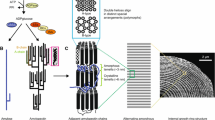Abstract.
Maize (Zea mays L.) cell cultures incorporated radioactivity from [14C]cinnamate into hydroxycinnamoyl-CoA derivatives and then into polysaccharide-bound feruloyl residues. Within 5–20 min, the CoA pool had lost its 14C by turnover and little or no further incorporation into polysaccharides then occurred. The system was thus effectively a pulse–chase experiment. Kinetics of radiolabelling of diferulates (also known as dehydrodiferulates) varied with culture age. In young (1–3 d) cultures, polysaccharide-bound [14C]feruloyl- and [14C]diferuloyl residues were both detectable within 1 min of [14C]cinnamate feeding. Thus, feruloyl residues were dimerised <1 min after their attachment to polysaccharides. For at least the first 2.3 h after [14C]cinnamate feeding, polysaccharide-bound [14C]diferuloyl residues remained almost constant at ≈7% of the total polysaccharide-bound [14C]ferulate derivatives. Since feruloyl residues are attached to polysaccharides <1 min after the biosynthesis of the latter, and >10 min before secretion, the data show that extensive feruloyl coupling occurred intra-protoplasmically. Exogenous H2O2 (1 mM) caused little additional feruloyl coupling; therefore, wall-localised coupling may have been peroxidase-limited. In older (e.g. 4 d) cultures, less intraprotoplasmic coupling occurred: during the first 2.5 h, polysaccharide-bound [14C]diferuloyl residues were a steady 1.4% of the total polysaccharide-bound [14C]ferulate derivatives. In contrast to the situation in younger cultures, exogenous H2O2 induced a rapid 4- to 6-fold increase in all coupling products, indicating that coupling in the walls was H2O2-limited. In both 2- and 4-d-old cultures, polysaccharide-bound 14C-trimers and larger coupling products exceeded [14C]diferulates 3- to 4-fold, but followed similar kinetics. Thus, although all known dimers of ferulate can now be individually quantified, it appears to be trimers and larger products that make the major contribution to cross-linking of wall polysaccharides in cultured maize cells. We argue that feruloyl arabinoxylans that are cross-linked before and after secretion are likely to loosen and tighten the cell wall, respectively. The consequences for the control of cell expansion and for the response of cell walls to an oxidative burst are discussed.
Similar content being viewed by others
Author information
Authors and Affiliations
Additional information
Received: 19 January 2000 / Accepted: 13 April 2000
Rights and permissions
About this article
Cite this article
Fry, S., Willis, S. & Paterson, A. Intraprotoplasmic and wall-localised formation of arabinoxylan-bound diferulates and larger ferulate coupling-products in maize cell-suspension cultures. Planta 211, 679–692 (2000). https://doi.org/10.1007/s004250000330
Issue Date:
DOI: https://doi.org/10.1007/s004250000330




